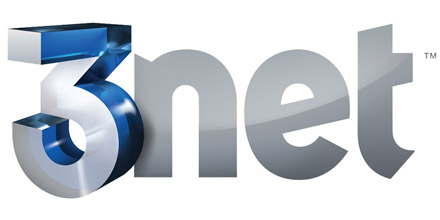Catching Up with 3net
WASHINGTON—3net, the 3D television network, celebrated its first anniversary last month. The network, a joint venture of Sony, IMAX and Discovery, is currently available to more than 19 million households in the U.S. and Canada on DirecTV (as well as BSkyB in the U.K).

TV Technology recently caught up with Tim Pastore, 3net’s vice president of development and programming at the 2012 Real Screen Summit in Washington D.C. Pastore spoke about 3net’s programming and growth strategy for the upcoming year.
TV TECHNOLOGY: How many hours of unique daily (non-repeating) programming does 3net have today, compared to when it launched?
TIM PASTORE: 3net launched Feb. 13, 2011, with three hours of programming on a Sunday evening. From then on we have been growing our library and the number of unique premieres. We premiered over 40 hours of programming in December alone.
TVT: Is 3net similar in design to Discovery’s erstwhile HD Theater (i.e. a cross section of all Discovery channels)?
PASTORE: Our brand is continuously evolving as we are an emerging network in a new medium. As a joint venture we are a cross section of our parent companies in general, providing a diverse array of genres and content in an effort to give everyone in the home something that appeals to them. As one of the few players in the 3D cable space, that diversity is critical for our audience, and for the medium in general.

Tim PastoreTVT: What is your peak viewing night and programming block?
PASTORE: We are currently focusing on our weekend primetime blocks as peak viewing periods.
TVT: What is your audience profile today?
PASTORE: As a general entertainment channel our demographic is very broad and evolving. We share a similar DNA with the flagship channel, but we’re also programming a kid’s block, premiering theatricals, music, sports, scripted shows, and even ran a short form comedy series, recently.
TVT: How much of 3net’s programming is commissioned for the network, versus acquired?
PASTORE: We will be shifting more attention towards commissions and co-productions this year as we begin to minimize the number of acquisitions.
TVT: What are the “ideal (3D) subjects” for 3net?
PASTORE: There are multiple genres and spaces that just scream to be in 3D—natural history, wildlife, travel, sports, music and children’s programming among them. But here at 3net we pride ourselves in exploring and pushing the boundaries of what a 3D program can look like and in which space or genre it can live. We created the first ever doc-series in 3D, plus short form comedy, and a history series. The 3D cable space is so new that I believe we will continue to discover, or perhaps rediscover, genres and stories that live outside the expectations of what makes an ideal 3D program.
TVT: Does 3Net ask producers to shoot for 3D and 2D broadcast simultaneously?

“African Wild” is an original 3D wildlife documentary series airing on the 3Net 3D channel.PASTORE: The often overlooked fact regarding 3D production is that an inherent 2D asset exists. Depending on the program and the structure of the deal, we may have clear 2D intentions for a program from the early stages of pre-production. However, the primary focus for all our productions is the 3D asset.
TVT: Are you collaborating with other (2D) Discovery Channels?
PASTORE: We have found great partnerships within the Discovery family. In 2011 several co-productions resulted in a 2D premiere on a family network and a 3D premiere on 3net including: “I Almost Got Away with It,” “Ghost Lab,” “The Haunted,” “Rise of the Jellyfish,” and others currently in production. We are continuing to execute the model of shooting a show in 3D and also airing the 2D asset as it brings forward strong creative properties across channels plus brand promotion and 3D awareness.
TVT: Are the technical barriers inherent with differing international standards even greater with 3D?
PASTORE: Global partnerships and co-productions always have frame rate conversions that need to be handled properly. But with 3D that emphasis is even greater as you are converting two separate eyes which need to match exactly. 3net has a phenomenal tech and post team which tackled many difficult conversions (i.e. 50i to 59.94i) last year and created new workflows that consistently ensure positive results. We are now in a positive space on successful workflows, but it has been no walk in the park getting here.
TVT: What is 3net’s strategy for narrowing the cost gap between 3D versus 2D production?
PASTORE: Closing the gap between 3D and 2D production is dependent on technology more than anything else. And technology has continued to evolve at a rapid rate, not only to close that gap, but to also allow for greater creative flexibility within budget. The cost gap has closed significantly since we launched. The latest models of cameras from Sony and Panasonic are increasing mobility, workflow, time management while decreasing crew sizes—all of which directly impact field production costs and post-production.
TVT: How is 3net generating income?
PASTORE: 3net is currently generating income through sponsored partnerships, branded vignettes and advertisements.
TVT: Are there other external factors which may impact the speed and success of 3net’s growth in 2012?
PASTORE: The largest factor is the consumer market and the sale of 3DTV’s and 3D capable devices. The overall sales in 2011 far exceeded projections and continues to move at a breakneck pace for a two-year technology. 2012 and 2013 should also show massive growth with projections that 1 in 3 homes in the US will have a 3D capable TV by 2014.
The professional video industry's #1 source for news, trends and product and tech information. Sign up below.
